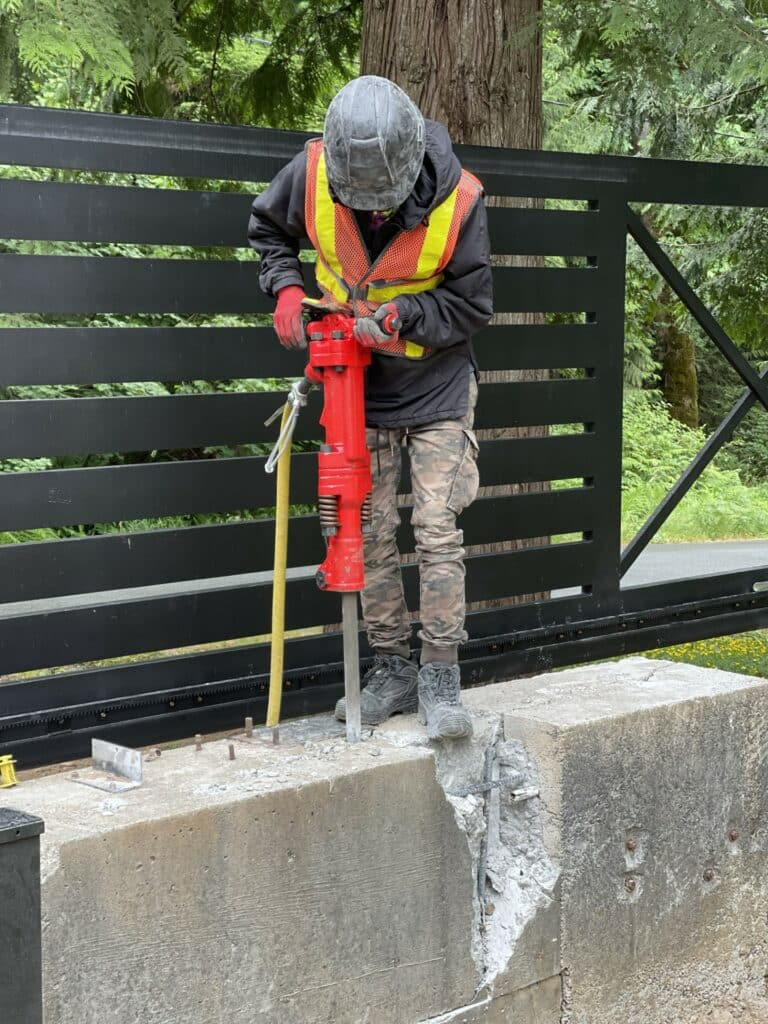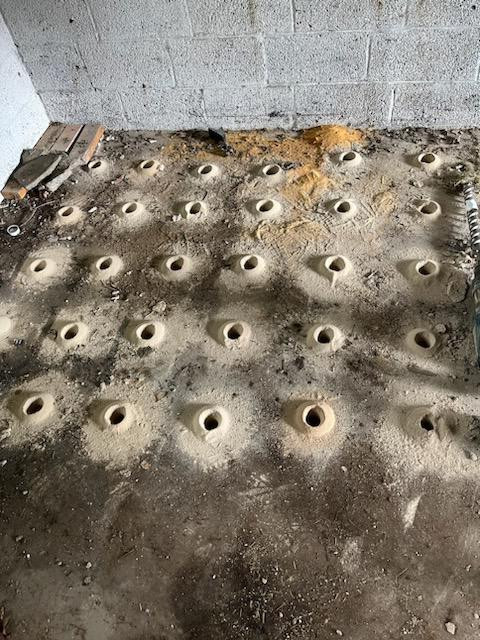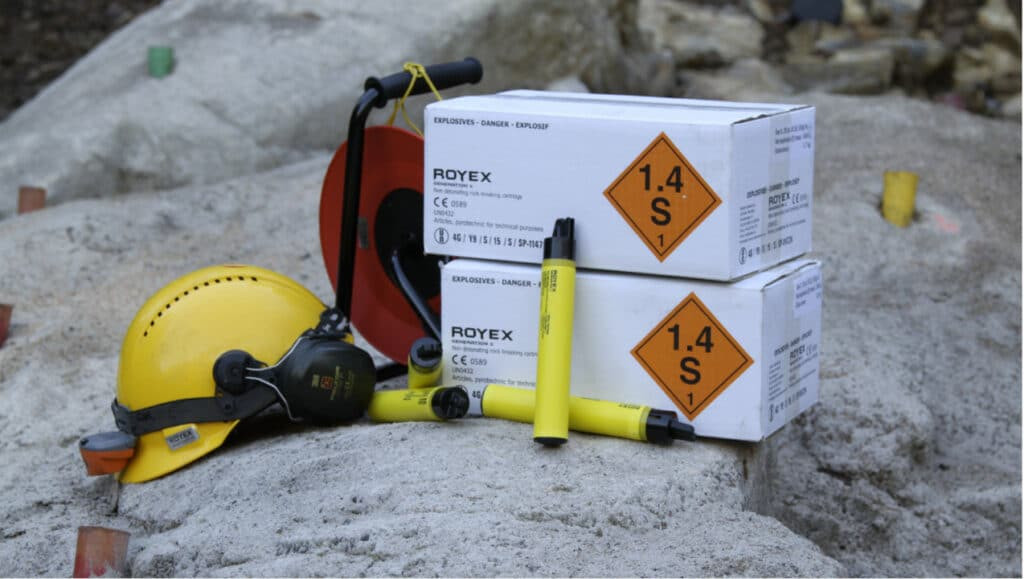Can A Jackhammer Break Rock? Absolutely, a jackhammer is indeed a powerful tool for fracturing rock, especially in landscape projects. Rockscapes.net is here to guide you through effective methods of rock breaking and hardscape construction, ensuring your project’s success.
1. Understanding the Power of Jackhammers for Rock Breaking
A jackhammer, also known as a pneumatic drill or demolition hammer, is a powerful percussive tool designed to break hard materials like rock, concrete, and asphalt. These tools are commonly used in construction, demolition, and landscaping projects to break down large rocks into manageable pieces. Jackhammers come in various sizes and power levels, each suited for different types of rock and project scales. How does a jackhammer work to break rock so effectively?
1.1 The Mechanism Behind a Jackhammer’s Force
Jackhammers operate using a piston that is driven by compressed air, electricity, or hydraulic systems. This piston strikes a tool bit, such as a chisel or moil point, with rapid and forceful blows. The repeated impacts create stress fractures in the rock, gradually breaking it apart. The effectiveness of a jackhammer depends on several factors, including the power of the tool, the type of bit used, and the properties of the rock being broken.
1.2 What Types of Rocks Are Best Suited for Jackhammers?
Jackhammers are most effective on dense and brittle rocks such as granite, basalt, and limestone. These rocks have a high compressive strength but can be fractured with repeated impacts. Sedimentary rocks like sandstone and shale can also be broken with a jackhammer, but they may require more time and effort due to their layered structure. However, you can explore a diverse selection of rocks perfect for your landscaping on Rockscapes.net.
1.3 Advantages of Using a Jackhammer
- Efficiency: Jackhammers can break rocks much faster than manual methods like sledgehammers and chisels.
- Versatility: They can be used in various applications, from breaking up concrete slabs to shaping rocks for landscaping.
- Accessibility: Jackhammers are readily available for rent or purchase at most construction equipment suppliers.
1.4 Disadvantages of Using a Jackhammer
- Noise and Vibration: Jackhammers are notoriously loud and produce significant vibrations, which can be disruptive and uncomfortable for the operator.
- Physical Demand: Operating a jackhammer requires considerable physical strength and stamina.
- Safety Hazards: The tool creates flying debris and poses a risk of injury if not used properly. It’s essential to wear appropriate personal protective equipment (PPE) such as safety glasses, ear protection, and gloves.
 Jackhammer breaking concrete for landscaping preparation
Jackhammer breaking concrete for landscaping preparation
2. Exploring Alternative Rock-Breaking Methods
While jackhammers are effective, they are not always the best solution for every rock-breaking situation. Depending on the size and location of the rock, as well as environmental and safety considerations, alternative methods may be more appropriate.
2.1 Expanding Grout: A Quiet and Controlled Method
Expanding grout, such as Rock-X and Rock-XX, is a non-explosive demolition agent that breaks rocks using expansive pressure. This method involves drilling a series of holes into the rock and filling them with a mixture of expanding grout and water. As the grout hydrates, it expands and generates pressure within the holes, causing the rock to crack and fracture.
2.1.1 Benefits of Expanding Grout
- Quiet Operation: Unlike jackhammers or explosives, expanding grout produces minimal noise, making it suitable for use in noise-sensitive areas.
- Controlled Breaks: The direction and extent of the fractures can be controlled by adjusting the spacing and alignment of the drilled holes.
- Safety: Expanding grout is a relatively safe method compared to explosives, as it does not produce flying debris or shockwaves.
2.1.2 Limitations of Expanding Grout
- Time-Consuming: The expansion process can take several hours or even days, depending on the type of grout, the temperature, and the properties of the rock.
- Temperature Sensitivity: The expansion rate of the grout is affected by temperature, so it may not be suitable for use in extreme hot or cold conditions.
- Drilling Required: The method requires drilling a series of holes into the rock, which can be time-consuming and require specialized equipment.
2.2 Hydraulic Splitters: Precision and Power
Hydraulic splitters use hydraulic pressure to drive a wedge between two pistons, which then exert force on the rock, causing it to split. This method is more precise than jackhammers and produces less noise and vibration.
2.2.1 Advantages of Hydraulic Splitters
- Precision: Hydraulic splitters allow for controlled breaks, minimizing damage to surrounding structures.
- Low Noise: They operate quietly compared to jackhammers and explosives.
- High Power: Hydraulic splitters can generate significant force, capable of breaking large rocks.
2.2.2 Disadvantages of Hydraulic Splitters
- Cost: Hydraulic splitters are expensive to purchase or rent.
- Drilling Required: Like expanding grout, hydraulic splitters require pre-drilled holes.
- Limited Reach: The splitting force is concentrated at the point of contact, so it may not be effective for breaking rocks with complex shapes.
 Expanding grout cracking rock
Expanding grout cracking rock
2.3 Sledgehammers and Chisels: Manual Rock Breaking
For smaller rocks or situations where noise and vibration are a concern, a sledgehammer and chisel can be used to manually break the rock. This method involves striking the chisel with the sledgehammer, gradually chipping away at the rock.
2.3.1 Benefits of Sledgehammers and Chisels
- Low Cost: Sledgehammers and chisels are inexpensive and readily available.
- Quiet Operation: They produce minimal noise and vibration.
- Precision: Manual rock breaking allows for precise control over the shape and size of the broken pieces.
2.3.2 Drawbacks of Sledgehammers and Chisels
- Labor-Intensive: Manual rock breaking is physically demanding and time-consuming.
- Limited Effectiveness: This method is only suitable for small to medium-sized rocks.
- Safety Risks: There is a risk of injury from flying debris and repetitive strain.
2.4 Explosives: Large-Scale Rock Removal
Explosives, such as dynamite or controlled blasting agents like Royex, are used to break large rock formations in construction, mining, and quarrying operations. This method involves drilling holes into the rock, placing explosive charges, and detonating them to create a powerful explosion that shatters the rock.
2.4.1 Advantages of Using Explosives
- Efficiency: Explosives can break large volumes of rock quickly and efficiently.
- Cost-Effective: For large-scale projects, explosives can be more cost-effective than other methods.
2.4.2 Disadvantages of Using Explosives
- Safety Hazards: Explosives pose significant safety risks, including the potential for accidental detonation, flying debris, and ground vibrations.
- Environmental Impact: Explosions can cause air and water pollution, as well as damage to surrounding ecosystems.
- Regulation: The use of explosives is heavily regulated and requires permits and specialized expertise.
 Explosives used for controlled blasting
Explosives used for controlled blasting
2.5 Diamond Wire Saws: Precision Cutting
Diamond wire saws use a diamond-impregnated wire to cut through rock. This method is precise and minimizes damage to surrounding areas.
2.5.1 Benefits of Diamond Wire Saws
- Precision Cutting: Diamond wire saws can make precise cuts through rock, minimizing waste and damage to surrounding areas.
- Versatility: They can be used to cut through various types of rock, including hard and abrasive materials.
- Low Vibration: Diamond wire saws produce minimal vibration, making them suitable for use in sensitive environments.
2.5.2 Drawbacks of Diamond Wire Saws
- High Cost: Diamond wire saws and the associated equipment are expensive to purchase and maintain.
- Specialized Skills: Operating a diamond wire saw requires specialized skills and training.
- Slow Cutting Speed: The cutting speed of diamond wire saws can be slow, especially when cutting through hard rock.
3. Choosing the Right Rock-Breaking Method
Selecting the appropriate method for breaking rock depends on various factors, including:
3.1 Type and Size of Rock
The type and size of the rock are primary considerations. Harder rocks like granite require more powerful methods such as jackhammers or explosives, while softer rocks like sandstone can be broken with expanding grout or manual methods. Larger rocks may necessitate the use of explosives or hydraulic splitters, while smaller rocks can be broken with a sledgehammer and chisel.
3.2 Location and Accessibility
The location of the rock and its accessibility also play a role in determining the best method. In urban areas or near sensitive structures, noise and vibration restrictions may limit the use of jackhammers or explosives. In remote locations with limited access, manual methods or expanding grout may be more practical.
3.3 Environmental Considerations
Environmental factors, such as the presence of water sources, sensitive ecosystems, or endangered species, may also influence the choice of rock-breaking method. Explosives can cause air and water pollution, while jackhammers can generate dust and noise that can harm wildlife. Expanding grout and hydraulic splitters are generally more environmentally friendly options.
3.4 Safety Concerns
Safety should always be a top priority when breaking rocks. Explosives pose significant safety risks and require specialized training and permits. Jackhammers can cause injuries from flying debris and repetitive strain. Manual methods can also result in injuries if not performed properly. It’s essential to assess the safety risks associated with each method and take appropriate precautions to protect workers and the public.
3.5 Cost and Time Constraints
The cost and time required to break the rock are also important considerations. Explosives can be the most cost-effective method for large-scale projects, but they also require significant upfront investment and planning. Jackhammers are relatively inexpensive to rent or purchase, but they can be time-consuming for breaking large volumes of rock. Expanding grout is a low-cost method, but it can take several days to complete the process.
4. Safety Tips for Rock Breaking
No matter which method you choose, safety should always be your top priority. Here are some essential safety tips to follow when breaking rocks:
4.1 Wear Appropriate Personal Protective Equipment (PPE)
Always wear safety glasses, ear protection, gloves, and sturdy footwear when breaking rocks. A hard hat may also be necessary when working in areas with overhead hazards.
4.2 Inspect Tools and Equipment
Before using any tools or equipment, inspect them carefully for damage or defects. Replace any damaged tools or equipment before starting work.
4.3 Clear the Work Area
Clear the work area of any obstacles or hazards. Make sure that there is plenty of space to move around safely.
4.4 Control Dust and Debris
Use water or dust suppressants to control dust and debris. This will improve visibility and reduce the risk of respiratory problems.
4.5 Follow Manufacturer’s Instructions
Always follow the manufacturer’s instructions for using tools and equipment. Do not attempt to modify or alter tools or equipment in any way.
4.6 Get Professional Help
If you are unsure about any aspect of rock breaking, consult with a professional. Rockscapes.net can provide expert advice and assistance to help you complete your project safely and efficiently. Address: 1151 S Forest Ave, Tempe, AZ 85281, United States. Phone: +1 (480) 965-9011. Website: rockscapes.net.
 Before and after rock breaking
Before and after rock breaking
5. Rockscapes.net: Your Partner in Rock Breaking and Landscaping
At Rockscapes.net, we understand the challenges of working with rocks in landscaping and construction projects. Whether you’re a homeowner tackling a DIY project or a contractor working on a large-scale development, we have the expertise and resources to help you succeed.
5.1 Wide Range of Rock Breaking Services
We offer a comprehensive range of rock-breaking services, including:
- Jackhammering
- Expanding grout application
- Hydraulic splitting
- Controlled blasting
- Diamond wire sawing
5.2 Expert Advice and Consultation
Our team of experienced professionals can assess your project needs and recommend the best rock-breaking method for your specific situation. We can also provide expert advice on safety, environmental considerations, and cost-effectiveness.
5.3 High-Quality Equipment and Materials
We use only the highest quality equipment and materials to ensure that your project is completed safely and efficiently. Our equipment is regularly inspected and maintained to ensure optimal performance.
5.4 Commitment to Safety and the Environment
We are committed to safety and environmental responsibility. We follow strict safety protocols and use environmentally friendly methods whenever possible.
6. Frequently Asked Questions (FAQs) About Rock Breaking
Here are some frequently asked questions about breaking rocks:
6.1 Can a jackhammer break any type of rock?
Jackhammers are most effective on dense and brittle rocks such as granite, basalt, and limestone. Softer rocks like sandstone and shale can also be broken with a jackhammer, but they may require more time and effort.
6.2 How long does it take to break a rock with expanding grout?
The expansion process can take several hours or even days, depending on the type of grout, the temperature, and the properties of the rock.
6.3 Is it safe to use explosives to break rocks near my home?
The use of explosives is heavily regulated and requires permits and specialized expertise. It is generally not safe to use explosives near homes or other structures without proper planning and precautions.
6.4 What is the best way to break a large boulder in my yard?
Hydraulic splitters or expanding grout are often the best options for breaking large boulders in residential areas. These methods are quieter and safer than jackhammers or explosives.
6.5 How can I minimize dust when breaking rocks?
Use water or dust suppressants to control dust and debris. You can also use a vacuum system to collect dust at the source.
6.6 Do I need a permit to break rocks on my property?
Permit requirements vary depending on local regulations. Contact your local building department or planning agency to determine if a permit is required for your project.
6.7 Can I rent a jackhammer from Rockscapes.net?
Yes, Rockscapes.net offers jackhammer rentals as well as a variety of other rock-breaking equipment. Contact us for more information about our rental services.
6.8 What safety precautions should I take when using a jackhammer?
Always wear safety glasses, ear protection, gloves, and sturdy footwear when using a jackhammer. Be aware of your surroundings and avoid striking underground utilities.
6.9 How much does it cost to hire a professional rock breaker?
The cost of hiring a professional rock breaker varies depending on the scope of the project, the type of rock, and the location. Contact Rockscapes.net for a free estimate.
6.10 What are the environmental impacts of rock breaking?
Rock breaking can have environmental impacts such as air and water pollution, noise pollution, and habitat disruption. It’s essential to use environmentally friendly methods and take precautions to minimize these impacts.
7. Real-World Applications of Rock Breaking
Rock breaking is an essential process in various industries and applications:
7.1 Construction
In construction, rock breaking is used to prepare sites for buildings, roads, and other infrastructure. It is also used to remove rock obstacles and create foundations.
7.2 Landscaping
In landscaping, rock breaking is used to create decorative features, retaining walls, and water features. It is also used to remove unwanted rocks and boulders from yards and gardens.
7.3 Mining and Quarrying
In mining and quarrying, rock breaking is used to extract valuable minerals and aggregates from the earth.
7.4 Demolition
In demolition, rock breaking is used to dismantle concrete structures and remove rock foundations.
8. Call to Action
Ready to transform your landscape with beautiful rock features? Visit rockscapes.net today to explore our wide selection of rocks and landscaping supplies. Contact us for expert advice and assistance with your rock-breaking project. Let us help you create the landscape of your dreams! Discover inspiring design ideas, learn about different types of rocks, and get expert tips for successful hardscape construction. Your dream landscape is just a click away!